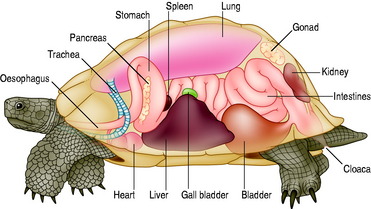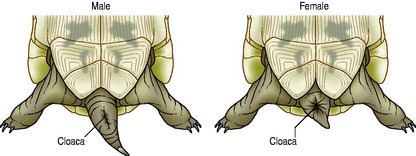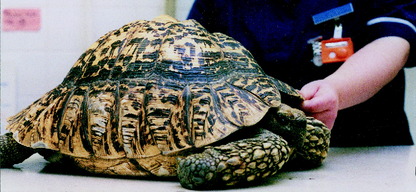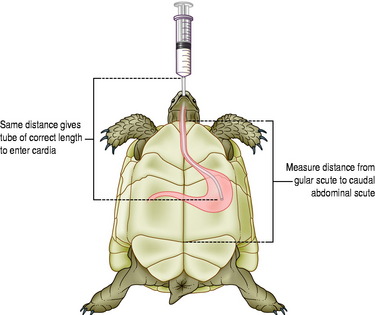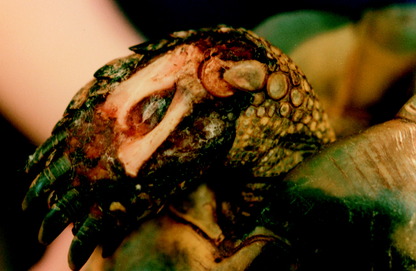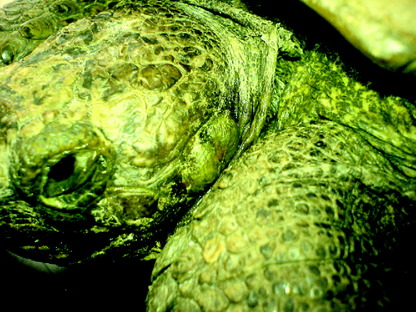Chapter 9 Tortoises and turtles
Chelonia, such as tortoises and their semi-aquatic relatives, terrapins (or turtles) are becoming very popular as pets, especially in Europe where there is a long history of keeping the Mediterranean Testudo species as house and garden pets. Although CITES II listed, this trade is being fuelled by the increasing availability of captive-bred specimens, especially from Eastern Europe.
Table 9.1 Commonly encountered tortoises and turtles: Key facts
| Species | Notes | Common disorders |
|---|---|---|
| The Mediterranean Testudo species including the southern European Herman’s tortoise (T. hermanni), members of the north African spur-thighed complex (T. graeca) and the Horsfield’s tortoise (T. horsfeldi) | These are small to moderately large species; most can be safely hibernated but see Hibernation for more details. Diet should primarily be leafy greens with added calcium supplementation. No animal protein should be given | Metabolic bone disease (MBD), chelonian herpes virus (CHV), ascarids |
| African spur-thighed tortoise Geochelone sulcata | This species from sub-Saharan Africa is a potential monster that can weigh up to 50–80 kg. They require tropical heat with relatively low humidity. Diet as for Testudo spp | Metabolic bone disease (MBD), chelonian herpes virus |
| The leopard tortoise (G. pardalis) | Another sub-Saharan African species. Requires tropical temperatures and a Testudo-like diet | Metabolic bone disease (MBD) |
| Red-footed tortoises (G. carbonaria) | Tropical South America. They need tropical temperatures, high humidity (70%) and a diet with more fruit that Testudo spp with a small amount of animal protein | Metabolic bone disease (MBD) |
| Red-eared slider (Trachemys picta elegans) | Less common in the European pet trade following several scares over Salmonella and concerns over alien releases. It is semi-aquatic and requires a dry, warm haul-out area on which to bask. They are carnivorous as hatchlings and feed on commercially available insect larvae, e.g. bloodworms; graduating up to sea foods such as prawns, fish, mussels and cockles plus calcium supplement. Commercial pelleted foods are available | Metabolic bone disease (MBD), hypovitaminosis A |
| Box turtles (Terrapene spp). | Omnivorous, requiring slugs, snails, earthworms, waxworms, mealworms, fruit, green leafed vegetables and mushrooms | Metabolic bone disease (MBD), tympanic scale abscesses |
Captive care
As with lizards, the long-term welfare of captive chelonia is intimately dependant upon their environment and they must be provided with appropriate temperatures, full spectrum diet and correct nutrition including a calcium supplement (see Lizards for more detail). This especially applies to hatchlings of the Testudo spp, where a vivarium is mandatory despite the relative hardiness of the adults.
Consultation and handling
Weight: length measurement as an indicator of health in mediterranean tortoises
Sexing
As a general rule, males have longer tails, a slit-like opening to the cloaca and a degree of concavity to the plastron, although this varies from species to species (Fig. 9.2). Chelonia have temperature-dependant sex determination and it is likely that variations in temperature at thermally-sensitive stages of embryonic development may produce a range of such secondary sexual characteristics, meaning that in some cases sexing is not an exact science.
Microchipping
Nursing care
Provide appropriate environment including provision of:
Fluid therapy
See ‘Fluid therapy’, in Lizards.
Nutritional support
Liquidized normal diet or proprietary support diets can be used, given either by stomach tube or by oesophagostomy tube.
Anaesthesia
For general notes, see ‘Anaesthesia’, in Lizards.
Induction and maintenance of anaesthesia in chelonia
Skin disorders
The scute epidermis consists of:
Differential diagnoses for skin disorders
Erosions, ulceration and shell deficits
Nodules and non-healing wounds
Findings on clinical examination
Management
Treatment/specific therapy
Respiratory tract disorders
Differential diagnoses for nasal tract disorders
Runny nose syndrome (RNS) is a poorly understood clinical syndrome. Linked with chelonian herpes virus, Mycoplasma agassizii and various bacteria. No single pathogenic agent as yet established.
Viral
Findings on clinical examination
Management
Lower respiratory tract disorders
Common respiratory signs
Differential diagnoses of dyspnoea:
Differential diagnoses of respiratory noise:
Findings on clinical examination
Treatment/specific therapy
Ear disorders
Management
Treatment/specific therapy
Stay updated, free articles. Join our Telegram channel

Full access? Get Clinical Tree


